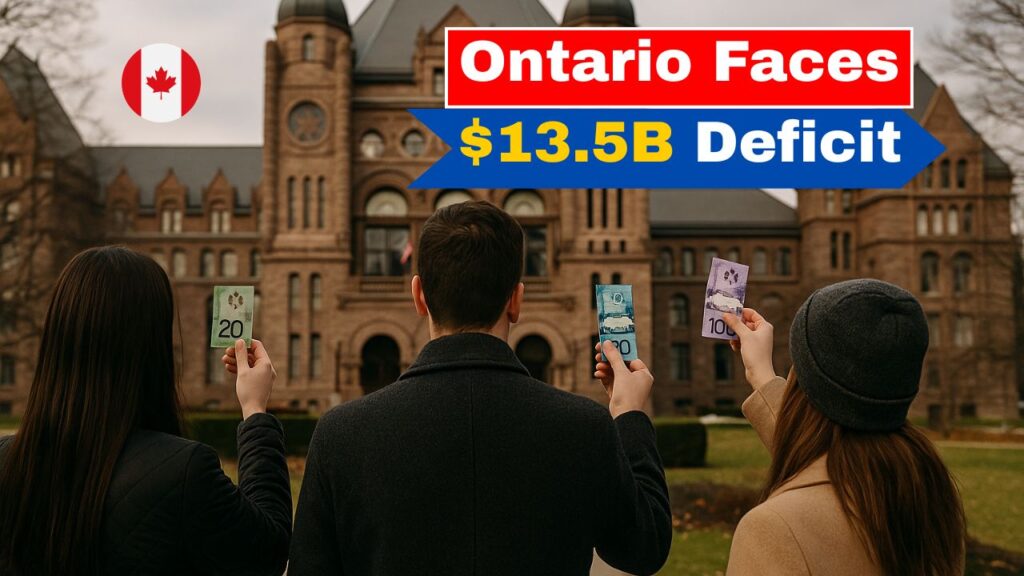Ontario Forecasts billion Deficit for 2025-26 – Ontario’s latest financial update has drawn major public attention as the province forecasts a C$13.5 billion deficit for the 2025–26 fiscal year. This projection highlights ongoing economic pressures that continue to shape spending, revenue, and long-term planning across Canada. The new outlook released on 20 November 2025 outlines how inflation, healthcare costs, and infrastructure commitments are influencing Ontario’s financial path. This article explores the updated projections, key fiscal indicators, and what the expected deficit means for households, businesses, and public programs within the Canadian economic landscape.

Ontario Budget Deficit Outlook for Canadian Residents
The projected Ontario budget deficit for Canadian residents reflects a combination of rising expenditures and slower-than-expected revenue growth. According to the updated forecast, healthcare remains the largest cost driver, followed by education and long-term infrastructure investments that have expanded significantly over the past two years. While economic activity has improved, tax revenues have not grown at the same pace, creating a wider fiscal gap. Authorities explain that the C$13.5 billion deficit is partly due to ongoing affordability measures introduced for households across the province. These supports remain essential for residents but add additional pressure on the provincial balance sheet, reinforcing the need for long-term fiscal planning.
Ontario Fiscal Pressures Affecting People Across Canada
The new economic outlook explains that several fiscal pressures are affecting people across Canada, particularly Ontario taxpayers. High inflation has increased the cost of delivering essential public services, while population growth has pushed demand for healthcare and housing support. At the same time, interest payments on provincial debt continue to rise, limiting available funds for new programs. Ontario’s Ministry of Finance emphasizes that while the deficit is notable, it remains manageable within the broader Canadian context. Efforts continue to focus on supporting vulnerable groups, stabilizing public spending, and encouraging private-sector investment to fuel long-term revenue growth across the country.
| Category | 2025–26 Projection |
|---|---|
| Estimated Deficit | C$13.5 billion |
| Healthcare Spending | Increasing by 6.2% |
| Revenue Growth | Moderate at 2.1% |
| Debt Servicing Costs | Rising to C$15.4 billion |
| Population Growth Impact | High service demand |
Ontario Economic Projections for the Canadian Economy
The Ontario economic projections indicate that while short-term challenges persist, the broader Canadian economy is expected to maintain moderate growth. Analysts predict that GDP expansion will improve slightly over the next fiscal year, supported by continued immigration, labour market stability, and business investment in technology and infrastructure. However, global uncertainties and domestic affordability issues may continue to restrict revenue growth. For the province, balancing public support programs with debt management remains a key priority. The outlook emphasizes cautious optimism, suggesting that Ontario could begin narrowing the deficit if current revenue trends strengthen and program spending becomes more targeted.
Ontario Financial Forecast Updates for Canadians
Recent financial forecast updates for Canadians show that both national and provincial governments are adjusting expectations to reflect economic headwinds. Ontario’s revised deficit estimate highlights the need for coordinated fiscal strategies to address rising costs and shifting demographic needs. Economists suggest that federal-provincial cooperation will play a crucial role in stabilizing budgets, especially as healthcare and housing pressures intensify. For everyday Canadians, the forecast signals a period of steady but slower growth, with government spending focusing heavily on essential services and long-term infrastructure to support economic resilience.
Frequently Asked Questions (FAQs)
1. Why is Ontario projecting a C$13.5 billion deficit?
The deficit is driven by rising healthcare costs, service demand, and slower revenue growth.
2. Does the deficit affect public services in Ontario?
Essential services will continue, but cost pressures may affect future program expansions.
3. How will the deficit impact Canadian taxpayers?
The impact varies, but long-term fiscal adjustments may influence future tax decisions.
 Ontario Cuts Gas Tax by 5.7 c/Litre, Delivering Approximate Household Savings of C$115 Yearly
Ontario Cuts Gas Tax by 5.7 c/Litre, Delivering Approximate Household Savings of C$115 Yearly
4. When could Ontario return to a balanced budget?
Analysts suggest balance may return once revenue growth increases and spending stabilizes.



